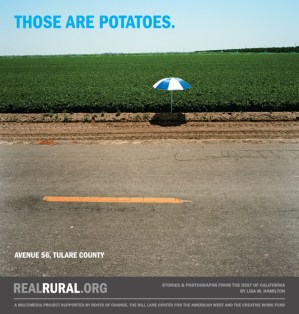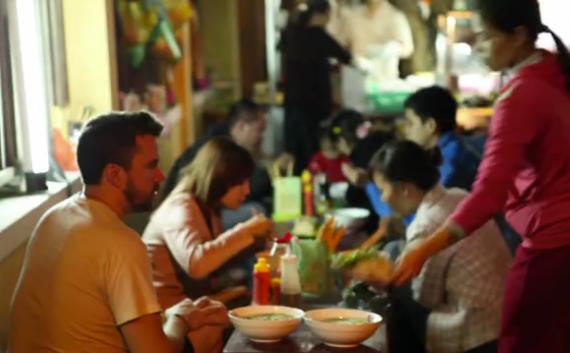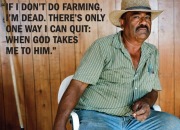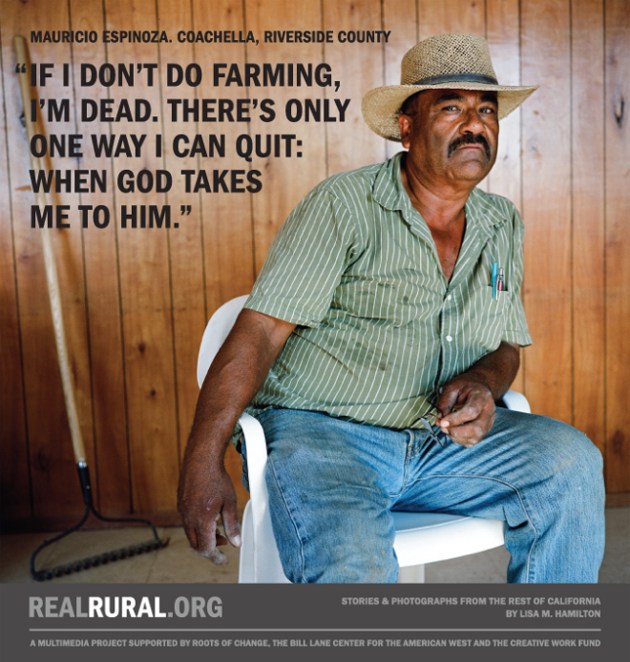You know that feeling you get when the door to someone else’s world opens just long enough that you forget you’re in your own? That slight expansion we experience when we hear someone’s true story is what motivated documentary photographer and writer Lisa Hamilton’s latest project, Real Rural (and all of her other work too, from what I can tell).
As the name suggests, the project is an effort to introduce the people of California’s cities to their often invisible, rural counterparts. Hamilton traveled nearly 10,000 miles around the Golden State taking photographs and asking questions about the lives of a wide range of people living in a range of landscapes. The result, which she describes as “a window onto the vast mosaic that is rural California,” is currently being displayed within the trains within the Bay Area Rapid Transit (BART) system. This fall, the photographs will also be shown at the California Historical Society museum, and there will be a concurrent ad-art campaign on billboards in Los Angeles and Sacramento.
“I don’t expect the photos and stories to cause a sea change in relationships or politics in California,” Hamilton told me recently. “I’m hoping that they lead to a change on a personal level.”
 Placing the photos within public transportation was a way to reach an audience of people who don’t necessarily spend time looking at photo books or in art galleries. BART, in particular, interested Hamilton because it often takes commuters on 30-45 minute rides in and out of San Francisco.
Placing the photos within public transportation was a way to reach an audience of people who don’t necessarily spend time looking at photo books or in art galleries. BART, in particular, interested Hamilton because it often takes commuters on 30-45 minute rides in and out of San Francisco.
“I’ve heard from people who’ve told me about spending their commute with Sebastian, the young boxer from Thermal, Calif., or looking at a field of potatoes in Tulare county,” she says. Alongside the photos, she places “a single inconclusive line of text that opens the story but doesn’t complete it. My hope is that people see that and it opens a little part of their brain that’s devoted to rural California, and suggests to them that it isn’t just what they’ve seen from I-5 [the largest highway, which intersects the state].”
The project is not solely focused on agriculture, but it’s not a coincidence that many of the more compelling people Hamilton met are ranchers, farmers, and farmworkers. She came away from writing her 2009 book, Deeply Rooted: Unconventional Farmers in the Age of Agribusiness, with a new curiosity about the role strong rural communities can play in fixing our food system.
 “The single most important thing we can do to change and improve agriculture is to exponentially increase the number of people who are involved with it,” says Hamilton. Because, she believes, humans on the land have the potential to have a very different impact than those who may own land and “farm or ranch from an office somewhere on a sheet of paper.”
“The single most important thing we can do to change and improve agriculture is to exponentially increase the number of people who are involved with it,” says Hamilton. Because, she believes, humans on the land have the potential to have a very different impact than those who may own land and “farm or ranch from an office somewhere on a sheet of paper.”
The people she did find — many of them farmworkers and their families — were often living in crushing poverty.
“There is this new class of invisible people in the U.S.,” she says. “[Rural poverty] is something very few people talk about outside of social justice circles. Agriculture is a major part of our economic engine in California and that poverty is an essential element in making that engine move forward.”
And while she steered clear of most of the more complex issues rural people face with Real Rural, she also hopes it sparks viewers’ curiosity about the vast divide between the city and the country. And makes them want to learn more.
“We were conscious not to make this an ad campaign for rural California. It’s not meant to tell people that things are good or bad or sad or pitiful or triumphant or anything,” she says. “It’s just about storytelling.”





